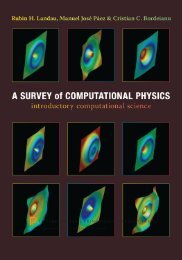- Page 8: Preface“More is different” is a
- Page 12: ContentsPart I General Principles1
- Page 16: ContentsIX7 Magnetic Materials ....
- Page 24: Part IGeneral Principles
- Page 28: 4 1 Thermal Equilibrium and the Pri
- Page 34: 1.2 Thermal Equilibrium 7environmen
- Page 38: 1.3 Kinetic Theory of Gas Molecules
- Page 42: 1.3 Kinetic Theory of Gas Molecules
- Page 46: 1.3 Kinetic Theory of Gas Molecules
- Page 54: 1.3 Kinetic Theory of Gas Molecules
- Page 58: 1.3 Kinetic Theory of Gas Molecules
- Page 62: 1.4 The Principle of Equal Probabil
- Page 66: 24 2 Entropyenergy is between E and
- Page 70: 26 2 Entropyand1T = ∂S (∂E = k
- Page 74: 28 2 Entropymeans that all the expr
- Page 78: 30 2 Entropy2.3.2 Equilibrium Condi
- Page 82: 32 2 EntropyFig. 2.4. Two systems s
- Page 86: 3The Partition Function and the Fre
- Page 90: 3.1 A System in a Heat Bath 37This
- Page 94: 3.3 Free Energy 39summation over th
- Page 98:
3.4 Internal Energy 41Hence,F = −
- Page 102:
3.6 Maxwell Relations 43From this e
- Page 106:
Part IIElementary Applications
- Page 110:
48 4 Ideal Gasesfunction and takes
- Page 114:
50 4 Ideal GasesFig. 4.2. Quantizat
- Page 118:
52 4 Ideal GasesFor N molecules, th
- Page 122:
54 4 Ideal GasesBefore closing this
- Page 126:
56 4 Ideal Gasesto avoid confusion,
- Page 130:
58 4 Ideal GasesWe can also verify
- Page 134:
60 4 Ideal GasesFor the calculation
- Page 138:
62 4 Ideal Gasespartition function.
- Page 142:
64 4 Ideal Gases4.7.4 Rotational Pa
- Page 146:
66 4 Ideal GasesExercise 11. Gibbs
- Page 150:
68 5 The Heat Capacity of a Solid,
- Page 154:
70 5 The Heat Capacity of a Solid,
- Page 158:
72 5 The Heat Capacity of a Solid,
- Page 162:
74 5 The Heat Capacity of a Solid,
- Page 166:
76 5 The Heat Capacity of a Solid,
- Page 170:
78 5 The Heat Capacity of a Solid,
- Page 174:
80 5 The Heat Capacity of a Solid,
- Page 178:
6The Elasticity of RubberIn this ch
- Page 182:
6.3 Entropy of Rubber 85Fig. 6.1. A
- Page 186:
6.4 Hooke’s Law 87This result rep
- Page 190:
90 7 Magnetic MaterialsTable 7.1. M
- Page 194:
92 7 Magnetic Materialsor antiparal
- Page 198:
94 7 Magnetic Materialsand( ) µBM(
- Page 202:
96 7 Magnetic MaterialsThis result
- Page 206:
98 7 Magnetic Materialslines betwee
- Page 210:
100 7 Magnetic Materialsvalue of M
- Page 214:
102 7 Magnetic MaterialsTable 7.2.
- Page 218:
104 7 Magnetic MaterialsFig. 7.8. R
- Page 222:
106 7 Magnetic MaterialsThis temper
- Page 226:
108 7 Magnetic MaterialsThus the tw
- Page 230:
110 7 Magnetic Materialsdependence
- Page 234:
Part IIIMore Advanced Topics
- Page 238:
116 8 First-Order Phase Transitions
- Page 242:
118 8 First-Order Phase Transitions
- Page 246:
120 8 First-Order Phase Transitions
- Page 250:
122 8 First-Order Phase Transitions
- Page 254:
124 8 First-Order Phase Transitions
- Page 258:
126 8 First-Order Phase Transitions
- Page 262:
128 8 First-Order Phase Transitions
- Page 266:
130 8 First-Order Phase Transitions
- Page 270:
9Second-Order Phase TransitionsBesi
- Page 274:
9.2 Landau Theory 135Every microsco
- Page 278:
9.2 Landau Theory 137⎧⎪⎨ 0 (T
- Page 282:
9.2 Landau Theory 139andU(T,V,N)=F
- Page 286:
whereand9.3 The Two-Dimensional Isi
- Page 290:
9.3 The Two-Dimensional Ising Model
- Page 294:
9.3 The Two-Dimensional Ising Model
- Page 298:
148 10 Dense Gases - Ideal Gases at
- Page 302:
150 10 Dense Gases - Ideal Gases at
- Page 306:
152 10 Dense Gases - Ideal Gases at
- Page 310:
154 10 Dense Gases - Ideal Gases at
- Page 314:
156 10 Dense Gases - Ideal Gases at
- Page 318:
158 10 Dense Gases - Ideal Gases at
- Page 322:
160 10 Dense Gases - Ideal Gases at
- Page 326:
162 10 Dense Gases - Ideal Gases at
- Page 330:
164 10 Dense Gases - Ideal Gases at
- Page 334:
166 10 Dense Gases - Ideal Gases at
- Page 338:
168 10 Dense Gases - Ideal Gases at
- Page 342:
170 10 Dense Gases - Ideal Gases at
- Page 346:
172 10 Dense Gases - Ideal Gases at
- Page 350:
174 10 Dense Gases - Ideal Gases at
- Page 354:
176 10 Dense Gases - Ideal Gases at
- Page 358:
178 10 Dense Gases - Ideal Gases at
- Page 362:
180 10 Dense Gases - Ideal Gases at
- Page 366:
Part IVAppendices
- Page 370:
186 Formulas Related to the Factori
- Page 374:
188 The Gaussian Distribution Funct
- Page 378:
190 The Gaussian Distribution Funct
- Page 382:
192 Lagrange’s Method of Undeterm
- Page 386:
194 Volume of a HypersphereNow let
- Page 390:
196 Hyperbolic FunctionsTheir deriv
- Page 394:
198 Boundary ConditionsHere n must
- Page 398:
GThe Riemann Zeta FunctionThe Riema
- Page 402:
References1. C. Seife: Science 302,
- Page 406:
206 Indexdensity of states 26diamon
- Page 410:
208 Indexsymmetry 134temperature 7,











![Práctica [PDF] - Universidad de Carabobo, FACYT - computacion](https://img.yumpu.com/48491415/1/190x245/practica-pdf-universidad-de-carabobo-facyt-computacion.jpg?quality=85)




